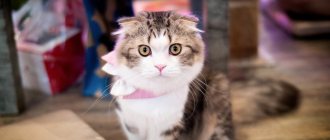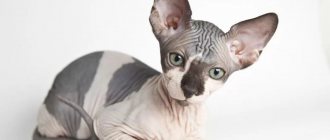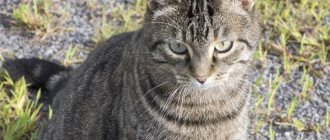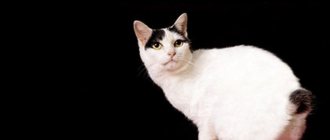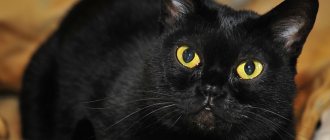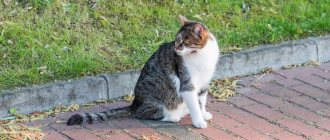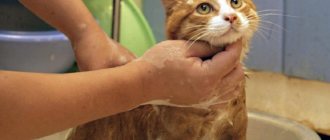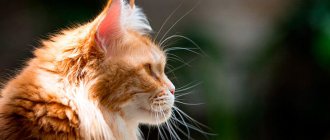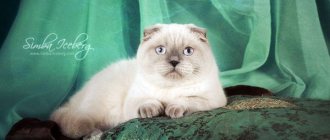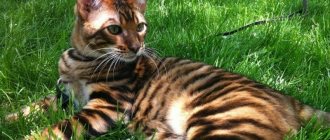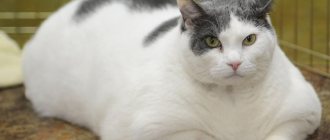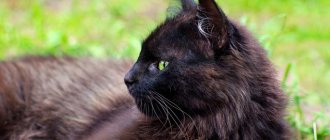Lilac coloring is included in the group of solid colors | solid (noble), is considered one of the few most beautiful and at the same time complex color schemes. It combines light shades of blue and pink, similar to spring forget-me-nots. It is surprising that this delicate color of the British lilac cat is difficult to convey through photography or describe in words.
The suit is presented in several modifications:
- Lilac;
- Dark purple, similar to a milk latte;
- Light pink.
British shorthair lilac cat
british longhair lilac – BRI c
Sometimes it seems as if Mother Nature turns into an artist and mixes various colors on her easel as she pleases. Her arsenal includes pink, blue, and gray. By adjusting the amount of each color, reducing or adding, nature colors little kittens.
Lilac color of British cats always pleases the eye with its lightness, looks elegant and is in demand.
History of appearance
Few people know, but the lilac color of British cats is also called the Isabella shade. This is not easy. The cats got their name in honor of Isabella of Bovard, the French queen. If you believe the story, then a woman, sending her husband on a long hike, promised him that she would not take off his shirt until she saw him again in front of her. During the separation, the linen acquired a light gray color, with a hint of pink.
As for when the purple British appeared, it is impossible to say for certain. Some note that this color has always existed, but there are so many shades that you won’t even understand that we are talking about a specific color.
Upbringing
Breeders believe that the lilac color of British cats affects their character. Such pets demonstrate an increased level of learning ability. Unlike blue-gray Britons, they love communication.
Lilac cats enjoy being the center of attention, as long as they choose to do so. A cat that gets into a large family at an early age shows less independence and independence, which is characteristic of the British breed.
Features and types of lilac color of British cats
The lilac Briton is one of the most unusual, but at the same time original and striking representatives of this breed. Breeders say that they began breeding animals of this color quite recently, although cats of this color could have been encountered earlier due to accidental mating. Lilac is a difficult color to obtain, which is a great success.
The lilac color is available in several shades.
This is about:
- dark purple;
- lilac, having medium saturation;
- light purple, it is very similar to gray-pink.
Today, you can most often find shorthaired lilac British cats, whose fur has a pinkish tint.
Important! It is just as difficult to bring out a shade of pink wool as another from the lilac series. Usually this happens completely by accident.
To develop the desired color, breeders have to work for quite a long time. At the same time, no one can guarantee 100% results. This is luck that cannot be avoided.
Lilac color is a cool color, but that’s where the beauty lies. The pink color should be present somewhere in the distance. In addition, based on standards, hairs must have the same tone along their entire length. Otherwise, we are already talking about a crossbreed, which cannot be classified as a purebred cat breed.
However, many people who have such a pet note its beauty and inimitability. And indeed, despite the fact that it will not be possible to obtain a passport due to some discrepancy, this will not in any way affect the originality and cuteness of the pet.
Myths and reality of cat colors
The diversity and variability of cat colors has been laid down by nature itself since ancient times . After all, the wild ancestors of our cute purrs had to survive by adapting to a variety of environmental conditions - where those with spotted or striped “camouflage” had the best chances. But the real color potential of cats began to gradually reveal itself when they entered the service of humans.
Color, as it turned out, matters
At first, people were much more interested in the behavioral qualities of the cat - its hunting skills; the selection went in this direction. But the prerequisites for the emergence and consolidation of new colors have become much greater. In many countries, cats were endowed with mystical properties and even deified, so the birth of kittens of an unusual color attracted attention - many very old signs, beliefs and superstitions are associated with cats of a certain color: black, white, red...
Famous British palette
The British breed is good in many respects, but is especially famous for the variety of its colors. The standards of felinological organizations recognize that the British have more than 250 color variations of their fur coats, which can be short, long, fluffy, inherited from the Persians.
A variety of British colors can be represented even in one litter
It was the Persians who gave British cats a motley palette of colors. British women had a much poorer color “assortment” until Persian blood began to flow into the breed - it is believed that the lilac shades were obtained precisely from oriental cats. Such “inbreeding” with Persian, Carthusian and outbred cats was necessary to preserve and develop the breed during difficult periods for it.
Lilac British kittens
Lilac British kittens have a slightly different appearance than adult animals. There is nothing surprising in this, because young pets still have “baby fur” for six months to a year, and only then it begins to change. Despite this, in young people the pads of the paws, the edging of the mucous membranes, and also the nose must necessarily match the color of the main coat, which initially has a gray-blue tint. After birth, the lilac kitten has blue-gray eyes. True, after time they change and become yellowish. In some animals you can even notice golden and copper ones.
Important! Sometimes newborn babies have light purple fur with scattered spots or stripes of a different color. This is a normal phenomenon, such deviations are allowed. By the age of one year they pass.
At the same time, if there is a contrasting undercoat, which does not change after reaching a certain age, it means that an error occurred during crossing and the lop-eared baby, although very beautiful, will not be classified as a member of the lilac family.
Inexperienced people believe that if you cross two British cats of lilac color, you will get babies of the same shade or a slightly different one. In fact, this is a blunder. Breeders note that such mating will lead to dulling of the fur of the cat babies. Instead of being colorful and bright, it will be as close to a gray shade as possible. In addition, in some “children,” the inclusions that appear do not go away with age. Therefore, it is better to refuse such experiments.
In addition to classic lilac cats, marble fluffies look amazing. However, they are so rare that it is impossible to admire them. The international names for lilac cats are Lavender and Lilac, although in the passport the breed and color are simply indicated by the letter “c”.
Pet fur
To achieve such an excellent result, specialists had to spend a lot of time. But it was not in vain. After all, these are really very beautiful British cats, whose fur has a slightly blue and slightly pink tint.
This result was obtained after crossing animals that had chocolate and blue coat colors. To some people, purple resembles the color of lavender. It is also called isabella.
This is a very soft, smooth and shiny wool. The shade should be uniform throughout the pet’s body, without any dots, stripes or patterns. The only thing is that if you look deep into the undercoat, the fur coat there may be a tone lighter than the main color.
Character
The character does not particularly depend on whether we are talking about short-haired lilac British or marbled ones. These two types of furry pets are very soft, charming and playful. They are not characterized by English stiffness and arrogance. The peculiarity of the breed is also that the pets remain playful until old age. Feeling good, they can resemble children even in old age.
Animals like to climb onto the highest furniture in the apartment and from there watch the people below. Cats are loyal and devoted to their owners, although they often do not show their love openly. The British try to stay close, but at the same time stay away. Breeders note that animals of this breed perfectly sense the owner’s mood, so when it wants to be better, the pets stay away, fearing to fall under the “hot hand.” Despite the non-conflict nature of the cat, it is better not to have a dog in the house, because the animal may develop jealousy and will stay away.
Who is the lilac Briton suitable for?
When choosing a Lilac pet, the important arguments are:
- British kittens, like their parents, have the same lilac-colored characteristics that will be a source of pride for their owner.
- The British have a soft, good-natured character; pets immediately become family favorites.
- Lilac is brought into a home with small children, and they get along well.
- They tolerate loneliness calmly and do not get bored, which is important for busy owners.
- Balanced by nature, they are clean and will not create a mess in the house.
Care
If you trace the history of the appearance of the British, it goes back more than one century. Purple shades, albeit interspersed, were present at that time. Therefore, caring for these animals, regardless of their color, is the same. Considering that pets are fluffy and stuffed, they should be brushed as often as possible. For these purposes, you should use special soft brushes that do not tear out the fur, but at the same time comb it perfectly. It is imperative to monitor your pets’ oral cavity, as well as their eyes and ears. Even if the animal is active and nothing bothers it, it should be examined by a veterinarian once a year and given the necessary vaccinations.
The right approach to feeding
The Lilac Briton's diet should be healthy and balanced. If the cat is on natural feeding, the following food should be present:
- turkey;
- chicken;
- rabbit;
- veal;
- eggs;
- vegetables;
- cereals
Veterinarians from the Zoovet clinic do not recommend giving fish and fermented milk products more than once a week. If necessary, the diet can be diluted with industrial complementary foods, but when choosing them it is important to take into account the gender, age and health status of the pet. It is recommended to focus on premium segment feeds.
How do you get such beauties?
Some people mistakenly believe that lilac cats are the result of crossing a marbled cat and a Scottish fold. In fact, such mating leads to genetic failures, as well as incorrect coloring, which does not even closely resemble lilac. A similar shade can be achieved using a color gene. If you introduce animals with recessive forms of blue and chocolate shades, you can hope to get purple offspring. And then the probability of success does not exceed 25%.
As already mentioned, there are several purple colors, they depend directly on the pigment present in the wool. There are two types of melanin. The first is pheomelanin - red-yellow, and the second is eumelanin - black. Depending on the ratios of these pigments in relation to each other, the final shade depends.
Did you like the article?
Choosing a nickname for the handsome lilac
When choosing a cat name, the designation of lilac color is always a priority. Although in this matter professional breeders prefer to adhere to their own rules. The names of all pets in the litter begin with a certain letter and often contain the brand name of the nursery or a combination of the parents' names.
Therefore, the little lilac Briton goes to a new owner with a name that is already recorded in the pedigree documents.
However, the owner can give the pet another “unofficial” nickname, which he will respond to at home.
- Dark purple British cats are sometimes called Isabella and derivatives of this name. This is a tribute to the isabella color, the second name for the color.
- Often there are names starting with the letter “L” - Lilu, Lyalya, Laska, Lavender.
- The nicknames traditionally include a reference to the English pedigree roots of this breed - London, Albina (apparently they mean Albion), York and even Westminster.
- For some time, aristocratic titles were in fashion - Count, Duke, Queen Margot (although this is closer to France, it is quite common in the pedigrees of British cats).
English cats have a complex character, but this in no way affects the persistent desire of fans of the breed to have just such an animal. The appearance of a new color in a group always causes a fresh wave of interest, and the lilac color is still among the rare and most sought after.
The only difficulty is the need to find a conscientious breeder, but such little things never stop true connoisseurs of cat beauty.
Content Features
Despite their natural health, Britons require proper care.
To extend your cat's life, choose the right food. Ideally, you should visit a veterinarian who will create a healthy diet. Take your pet to the veterinarian regularly: the cat will not complain if it gets sick.
Below are the best foods for British Shorthair cats:
It's easy to care for the cat's fur - buy a massage slicker brush and brush your cat 2 times a week. The Briton needs to be washed a couple of times a year or as needed.
Pay attention to the animal's eyes - they are looked after every day. A cotton pad is used to remove natural discharge from the eyes, and the cotton wool is led from the outer corner to the nose
The ears are examined a couple of times a month and cleaned with cotton wool treated with a hygienic solution.
You need to examine your pet's teeth every day to prevent tartar from developing. Breeders recommend teaching your British cat to brush his teeth from an early age.
Such pets are sensitive to drafts and catch colds easily: protect your cat from drafts.
Chinchilla
The British chinchilla cat is a species specially bred artificially. Its fur is similar to that of the rodent whose name it bears. This color is one of the most exotic and expensive. The British chinchilla has dense, short and thick fur with a well-developed undercoat.
The main color types are described below.
Silver
Interesting! The silver chinchilla is the most common option among cats of this color.
This color is characterized by a bright apricot thick undercoat. The tipping of the main coat is black or blue. The color of the nose, eye rims and paw pads corresponds to the shade of the tips of the coat. There are no stripes, spots or any other inclusions. The coloring is uniform, darker on the sides, back and tail.
The fur is darker than silver. The tipping is painted on a third of the entire length. All other characteristics are the same, but dark fur is also visible between the tips of the fingers.
Interesting! In addition to the British, Scottish, Persian and Burmese cats also wear the chinchilla color.
British golden chinchilla
Where did the British lop ears come from?
Initially, forward-dropping ears were a breed-forming feature of the Scottish cat. And the latter was known in Great Britain back in the middle of the 19th century.
British Fold cats are descendants of Scottish cats
Some written sources report the arrival of fold-eared seals in Foggy Albion from China. Others claim that France is the birthplace of such fluffy creatures.
One way or another, interest in the breed began to grow among breeders only after the Second World War. The beginning of the development of the Scottish variety of purrs was the appearance in 1959 of the offspring of a cat with ears pressed to its head, belonging to Mr. William Ross. And since 1961, these cute creatures began to spread throughout Europe.
In parallel, the history of the British Shorthair cat developed, the first exhibition of which took place back in 1871 under the supervision of breeder Harrison Fair. Further, in 1950, the breed was recognized by American felinological organizations and since then began to spread throughout the world.
After the 1990s. Since both British and Scottish cats entered Russia, the question arose about expanding the population of both breeds. For these purposes, the breeders decided to cross representatives of two varieties of purrs. This is how the breed of British Fold cats began to develop. The difference between the new fluffies was short, “stuffed” hair on a massive body (the heritage of the “British”) and forward-curved ears (like those of the “Scots”).
The young breed began to be in demand among ordinary people, but in 2004 the world felinological community issued a ban on crossing cats of the British and Scottish breeds. The reason was the negative impact of such breeding on the health of pets. Such purrs are often born with sore joints and hard-textured fur.
Thus, to this day, British Fold cats are considered an unofficial breed, and many breeders generally classify these fluffy cats as discarded Scottish cats.
